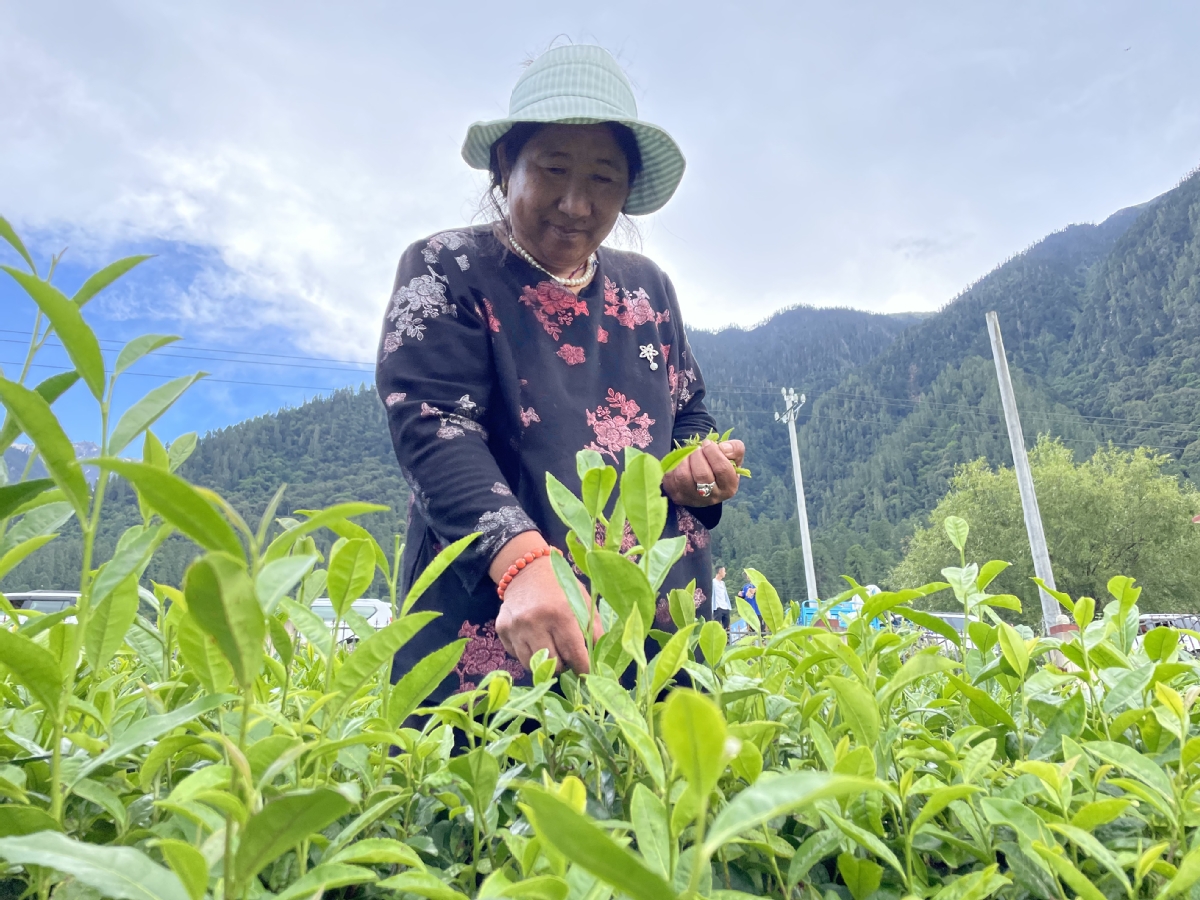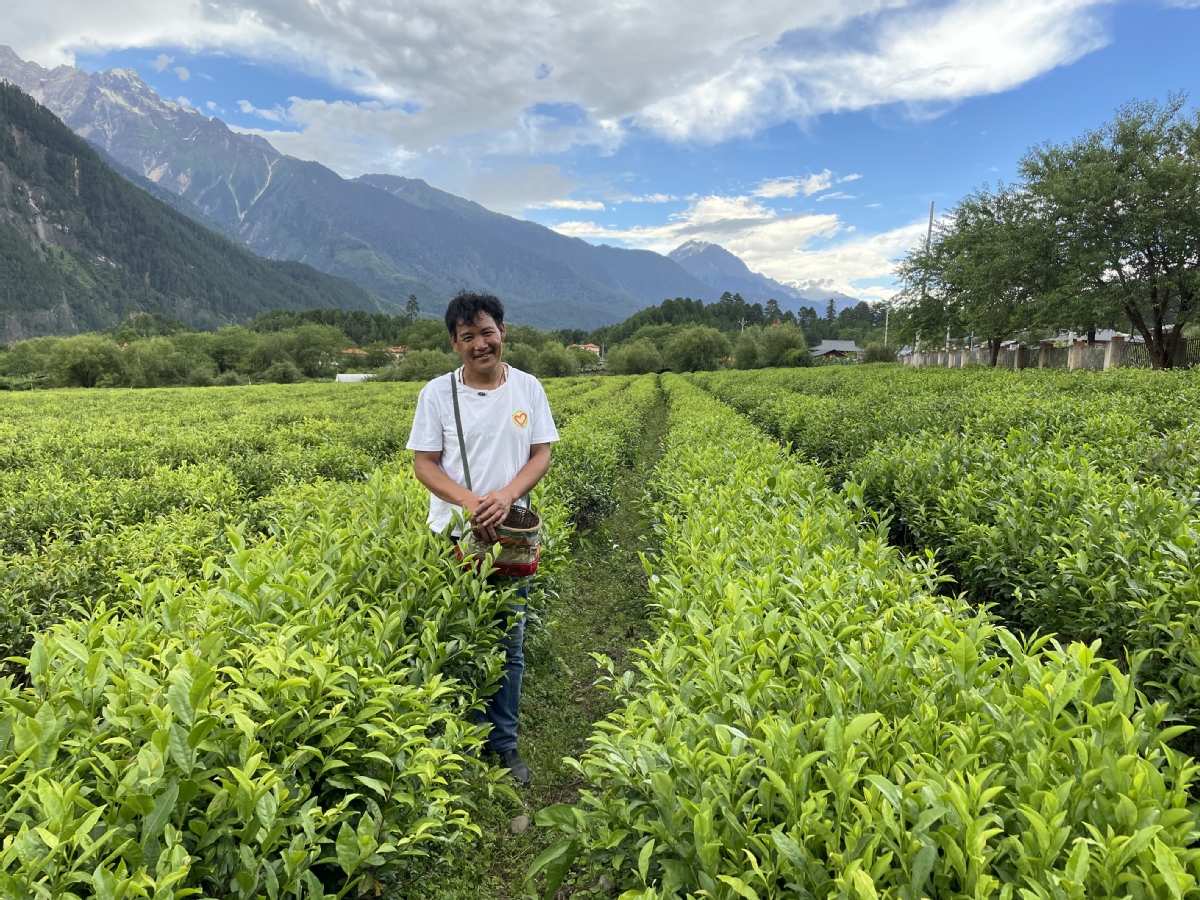
Huang Hualin, a tea expert from Guangdong Academy of Agricultural Sciences Tea Institute, teaches farmers planting techniques at Yigong Tea Plantation in Nyingchi, Tibet autonomous region. [Photo by Zhang Yangfei/chinadaily.com.cn]
The world's highest tea garden in Nyingchi, Tibet autonomous region, aims to drive local economic development to a new level by combining green tea trees with "Red" culture derived from the peaceful liberation of Tibet in the 1950s.
The Yigong tea plantation is located deep in Bomi county. It is the highest tea plantation in the world, as well as the first and only tea producer in the region.
Dai Bao, deputy head of the plantation, said the unique environment in Bomi helps ensure the tea's good quality. The area sits at an average altitude of around 2,000 meters, the highest elevation tea trees can adapt to. In addition, the river valley and dense forests provide abundant precipitation and oxygen, and the soil acidity is also ideal for tea growth.
Huang Hualin, a tea expert from the Guangdong Academy of Agricultural Sciences Tea Institute, said because of the relatively low temperatures on the plateau, the dormancy period of tea trees in Yigong is relatively long.
"It makes the tea leaves accumulate more nutrients and taste sweeter and richer," he added.

A Tibetan farmer collects tea at Yigong Tea Plantation in Nyingchi city. [Photo by Zhang Yangfei/chinadaily.com.cn]
The tea plantation has played an important role in bringing local people more wealth. The plantation is operated by a State-owned company, which employs and pays local farmers and herdsmen to cultivate the fields.
It has an area of 340 hectares, producing black tea, green tea and other tea products. Last year, the farm produced 171,000 kilograms of tea products with an output value of 27.4 million yuan ($4.2 million), and employees received an average annual income of 22,000 yuan, an increase of 37.5 percent over 2019, according to Dai.
The plantation's Red culture — having to do with Communist Party of China history — can be experienced at a small two-story house built of rock and timber. A stone monument stands in front of the building, reading "General Building" in red characters.
The building was the residence and workplace of General Zhang Guohua, army commander of the 18th Corps, a military formation of the People's Liberation Army which entered Tibet in 1950 as the major force of the liberation.

A Tibetan farmer works at Yigong Tea Plantation in Nyingchi city. [Photo by Zhang Yangfei/chinadaily.com.cn]
After the peaceful liberation of Tibet, the 18th Corps was disbanded in 1952, and some of the officers and soldiers stayed in Yigong, where they were responsible for constructing and cultivating farms for military supplies.
They started by planting both fruit and tea trees in 1960, but they later discovered that the local environment was more conducive to the growth of tea, so they decided to focus on tea planting and introduced small-leaf tea trees from neighboring Sichuan province, marking the first large-scale tea plantation in Tibet.
Tibetan people have a long history of drinking tea — especially butter tea, which consists of strong tea, yak butter, salt and nuts. The demand for tea was very high, and before the construction of Yigong, the people had to rely solely on imports of tea from other regions, which led to the creation of the famous Tea Horse Road in ancient times.
"The Yigong tea plantation itself is the result of democratic reform in Tibet, reflecting the course of the region's socioeconomic development as well as a very rich Red culture," Dai said.
"Next, we hope to promote our two images — the plateau tea and Red Yigong and integrate them, making green tea and Red culture the new impetus for the development of the Yigong tea plantation," he added.

Tibetan farmers work at Yigong Tea Plantation in Nyingchi city. [Photo by Zhang Yangfei/chinadaily.com.cn]

